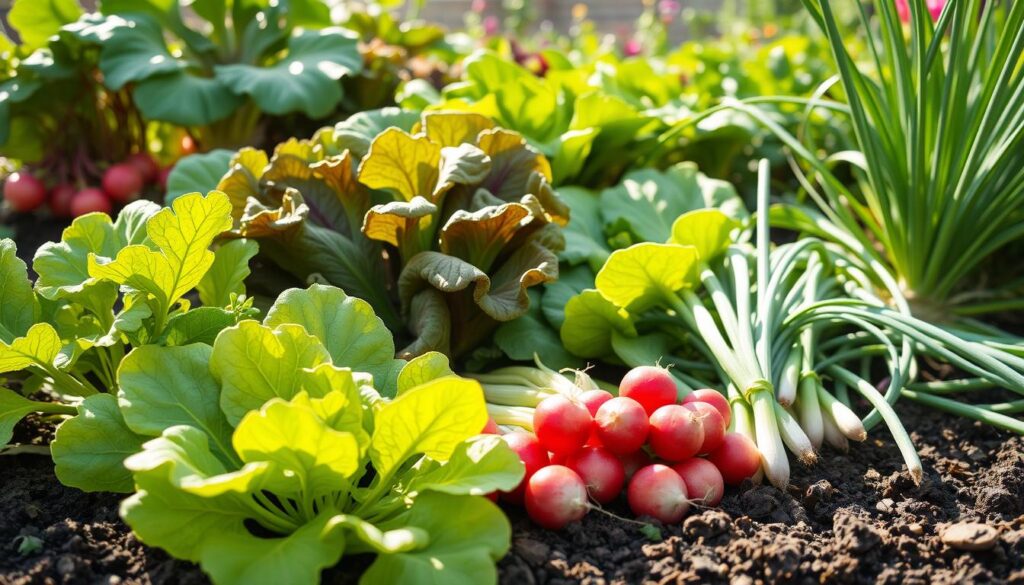In vegetable gardening, time is key. Luckily, many fast-growing crops offer a quick harvest. This means you can enjoy your homegrown food sooner. Here, we’ll look at the top 10 fast-growing vegetables. They’re great for beginners or those with little space, offering fresh, tasty produce fast.
Key Takeaways
- Discover 10 fast-growing vegetables that can be harvested quickly
- Learn about the benefits of growing your own fast-growing crops
- Understand the unique characteristics and growing requirements of each fast-growing vegetable
- Explore tips for planting, caring, and incorporating these speedy crops into your meals
- Gain insight into extending the growing season and troubleshooting common issues
The Joy of Growing Your Own Food
Becoming a home gardener is incredibly rewarding. It connects you to the benefits of growing food and nature. You get to enjoy the fresh produce and homegrown food you’ve grown. It fills you with a sense of accomplishment and appreciation for nature.
Growing your own food helps you connect with the earth’s rhythms. Watching your plants grow and produce food is amazing. It teaches you about nature’s balance and the effort to get fresh, nutritious food.
Eating Fresh and Nutritious Produce
Enjoying the fresh produce and homegrown food you grow is a big joy. Harvesting your vegetables at the right time makes them taste better and be more nutritious. Growing your own food is good for your health and well-being.
“Gardening is a great way to connect with nature, get some exercise, and enjoy the freshest produce possible.”
Whether you have a big backyard or a small balcony, growing your own food is rewarding. It nourishes your body and soul. Home gardening is a fulfilling experience.
What are Fast-Growing Vegetables?
In gardening, fast-growing vegetables are a special group. They are loved by gardeners who want a quick harvest. But what makes them different from other vegetables?
Fast-growing vegetables go from seed to plate in weeks or months. This is much faster than the months it takes for many other vegetables. They are perfect for gardeners with little space or who want to eat their harvest sooner.
The main traits of fast-growing vegetables are:
- Rapid Maturation – They grow fast and are ready to eat in a short time.
- Compact Growth Habit – They are smaller and need less space in the garden.
- Short Growing Seasons – They can be picked in as little as 3-8 weeks, depending on the variety.
Knowing about fast-growing vegetables helps gardeners plan better. They can enjoy fresh, homegrown food all season. Next, we’ll look at the top 10 fast-growing vegetables for your garden.
Top 10 Fast-Growing Vegetables for a Quick Harvest
In vegetable gardening, time is key. Luckily, many fast-growing crops offer a quick harvest. These top 10 quick-harvest vegetables are perfect for both seasoned and new gardeners. They bring fresh, homegrown produce right to your table.
Radishes: Ready in as Little as Three Weeks
Radishes are amazing. They can be ready in just 3 weeks. Their short season and easy growth make them great for quick results.
Lettuce: Crisp and Fresh in a Month
Lettuce is another fast-growing veggie. It can be ready in 4 to 6 weeks. This gives you fresh leaves for salads and sandwiches.
Adding these fast-growing veggies to your garden means quick harvests. Enjoy the taste of homegrown food from your backyard!

| Vegetable | Time to Harvest | Key Features |
|---|---|---|
| Radishes | 3-4 weeks | Crunchy, peppery flavor; easy to grow |
| Lettuce | 4-6 weeks | Crisp, nutrient-dense leaves; great for salads |
| Arugula | 3-4 weeks | Peppery, flavorful leaves; fast-maturing |
| Spinach | 4-6 weeks | Nutrient-rich, versatile leaves; thrives in cool weather |
| Turnips | 4-6 weeks | Crisp, mild-flavored roots; can be grown year-round |
Planting and Caring for Fast Crops
To grow a garden full of fast-growing vegetables, you need to focus on soil and seed care. Knowing what these quick crops need helps them grow well. This way, you’ll have a lot of food in no time.
Soil Preparation
Healthy, fast-growing veggies start with good soil. Add compost or manure to your garden bed. This makes the soil better for growing and helps water drain well.
Make sure to mix the compost well. This ensures the soil is evenly enriched.
Seed Starting
Some veggies like radishes and lettuce can be planted directly. But starting seeds indoors can give them a head start. This way, you control their growing environment.
When planting seeds, follow the packet’s advice on depth and spacing. This is key for them to grow well.
| Vegetable | Seed Starting | Direct Sow |
|---|---|---|
| Radishes | ✓ | ✓ |
| Lettuce | ✓ | ✓ |
| Arugula | ✓ | ✓ |
| Spinach | ✓ | ✓ |
| Carrots | ✓ |
After your seeds sprout, give them the right care. They need sunlight, water, and protection from pests. With the right care, your veggies will grow well and give you a great harvest.
Harvesting Your Bounty
Properly harvesting fast-growing vegetables is key to enjoying your hard work. I’ll guide you on when and how to harvest each crop. This way, you can maximize the yield and extend the harvest period. By using the best proper harvesting techniques, you’ll get the most from your quick-growing garden.
The timing of your harvest is very important for flavor and texture. For example, radishes are best when small and tender, usually in three to four weeks. Lettuce is ready when its leaves are big enough, about four to six weeks after planting.
Harvesting techniques differ for each vegetable. For leafy greens, take the outer leaves gently to let the inner ones grow. Root veggies like beets and carrots need a fork to avoid damaging the roots. For cucumbers and zucchini, just cut them off with sharp scissors or pruners.
Proper storage is key to maximizing the yield and keeping your veggies fresh longer. Store leafy greens and herbs in the fridge. Root veggies and fruits do well in a cool, dark spot. With the right harvesting and storage, you’ll enjoy your garden’s bounty for weeks.
“The true harvest of my daily life is somewhat intangible and undescribable as the tints of morning or evening. It is a little star-dust caught, a segment of the rainbow I have clutched.”
– Henry David Thoreau
Incorporating Fast Veggies into Your Meals
After growing your fast veggies, it’s time to use them in tasty meals. Radishes and lettuce add crunch and flavor. They make your homegrown food both tasty and healthy.
Delicious and Nutritious Recipes
Start with a refreshing smoothie with leafy greens and radishes. For lunch, make a colorful salad with lettuce, carrots, and cherry tomatoes. Roast zucchini, bell peppers, and onions for a tasty side dish at dinner.
Fast-growing veggies can spice up any recipe. They add flavor and nutrition to your meals. Whether it’s a stir-fry or a new dish, they’re perfect.
“The joy of growing your own food is not just in the harvest, but in the satisfaction of nourishing yourself and your loved ones with the fruits of your labor.”

Let fast-growing veggies inspire your cooking. Try new recipes that show off their flavors and health benefits. Your taste buds and body will love it!
Extending the Growing Season
Fast-growing vegetables give you a quick harvest. But, you can also extend the growing season. This way, you can enjoy your crops for longer, making your garden more fruitful.
Cold frames are a great method. They work like mini greenhouses, keeping plants safe from cold and bad weather. This lets you start growing earlier in spring and keep going into fall.
Row covers are another useful tool. These light fabrics trap heat and keep pests away. They’re perfect for quick-growing veggies like radishes, lettuce, and spinach.
Succession planting helps too. It means planting your fast-growing crops in batches. This way, you get fresh produce all season long. For example, plant radishes every two weeks for a steady supply.
| Season Extension Technique | Benefit |
|---|---|
| Cold Frames | Protects plants from frost and harsh weather, extends growing season on both ends |
| Row Covers | Traps heat, shields plants from pests, allows for earlier planting and later harvests |
| Succession Planting | Provides a continuous supply of fresh produce throughout the season |
Using these techniques, you can enjoy your fast-growing veggies longer. This extends the growing season and prolongs your vegetable harvests.
“The secret to a long harvest season is in mastering the art of season extension.”
Companion Planting for Optimal Growth
Creating a great vegetable garden is like art. One key technique is companion planting. This method involves growing different plants together. It helps your quick-growing crops grow better and stay healthy.
Beneficial Plant Combinations
In companion planting, it’s all about finding plants that help each other. Here are some great pairs for your fast-growing veggies:
- Radishes and carrots: Radishes make the soil easier for carrots to grow.
- Marigolds and tomatoes: Marigolds keep pests away from your tomatoes.
- Basil and tomatoes: Basil makes tomatoes taste better and keeps aphids off.
- Nasturtiums and cucumbers: Nasturtiums draw in good bugs that eat cucumber pests.
Choosing and arranging these beneficial plant combinations wisely can make your garden a perfect ecosystem. It boosts the growth and yield of your fast-growing veggies.
| Plant Combination | Benefit |
|---|---|
| Radishes and Carrots | Radishes help loosen the soil for carrots to thrive. |
| Marigolds and Tomatoes | Marigolds repel harmful pests, protecting tomato plants. |
| Basil and Tomatoes | Basil enhances the flavor of tomatoes and deters aphids. |
| Nasturtiums and Cucumbers | Nasturtiums attract beneficial insects that prey on cucumber pests. |
By using companion planting, you can make your garden a thriving, connected space. Try out different plant pairs and see how nature’s teamwork can help your veggies grow.
Troubleshooting Common Issues
Starting your fast-growing vegetable garden can come with challenges. Pests and diseases are common problems. Knowing how to solve these issues is crucial for a successful harvest. Here, I’ll share practical tips to help you overcome these obstacles.
Pests like aphids, cabbage worms, and slugs can harm your crops. Use natural methods to fight them off. Try companion planting, introduce beneficial insects, or use organic pest control. Regular checks and quick action can keep pests away.
Diseases such as powdery mildew and root rot can also affect your vegetables. Good soil, enough space, and air circulation help prevent diseases. If you see disease signs, remove affected parts and use organic fungicides or resistant varieties.
Extreme weather, drought, or too much water can stress your plants. Mulching, providing shade, and adjusting watering can help. These steps ensure your plants thrive despite environmental challenges.
Knowing how to tackle common issues lets you enjoy a successful harvest. With the right strategies and attention, you’ll have a rewarding growing season.
| Issue | Symptoms | Solutions |
|---|---|---|
| Pests |
|
|
| Diseases |
|
|
| Environmental Stresses |
|
|
“With the right troubleshooting strategies, you can overcome any obstacle and enjoy a bountiful harvest of fast-growing vegetables.”
The Satisfaction of a Quick Harvest
Growing your own fast-producing vegetables is very rewarding. It gives you a sense of accomplishment and connects you to nature. The joy of eating fresh, flavorful produce you grew is unmatched.
Celebrating Your Green Thumb
Enjoy the crisp greens or juicy radishes you’ve grown in weeks. Feel proud of your gardening success. A thriving garden shows your dedication and green thumb.
Using your homegrown ingredients in a salad or dish feels great. It makes you feel connected to nature. Share your harvest with loved ones or enjoy it yourself.



Leave a Reply